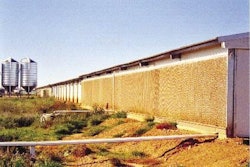H5N1 subtype of the avian influenza (AI) virus is a disease of animals, overwhelmingly birds but with potential for adaptation into a zoonotic dimension. Zoonoses are diseases passed from animals to humans.
H5N1 has become pandemic in poultry in some regions but there is constant fear of mutation and re-assortment with human influenza viruses to produce strains that are virulent and easily passed to and between people. Pharmaceutical industries are in a frantic game of ‘catch-up’ trying to design, develop and produce well matched vaccines for a dynamic virus undergoing constant change.
Other weapons in the armoury are anti-viral drugs such as oseltamivir (Tamiflu; Roche) currently stockpiled around the world for use as curative and prophylactic treatment in the event of a human ‘flu pandemic. Oseltamivir is a so-called ‘neuraminidase inhibitor’, targeting the neuraminidase surface protein to prevent new virus particles emerging from infected cells.
The drug is used to treat human cases of H5N1 in a number of countries. Among those already receiving oseltamivir as a prophylactic are veterinarians and poultry workers responsible for culling and clearing up after H5N1 events, such as the recent outbreak on a UK turkey farm.
Over 160,000 birds were caught, culled, loaded and transported for incineration in just three days. Personnel including vets and poultry workers carrying out the cull and disinfection ready for re-stocking were reported to be taking Tamiflu as part of a general programme of precautions. Tamiflu is active against influenza A and B viruses, the latter a cause of common human ‘flu.
Most chemicals used to control fast replicating micro-organisms are subject to the development of resistance by pathogens. With so much happening so quickly around the world, serious H5N1 situations are under-reported. The Egyptian situation is a classic example with poultry hit hard and 23 human cases including 13 deaths – the highest outside of Asia.
Two people in a family cluster at Gharbiyah province north-west of Cairo in December 2006 were killed by an H5N1 strain resistant to oseltamivir. This strain with the so called ‘294S’ genetic change first emerged in Vietnam in 2005 but Egypt provided the first evidence of any spread outside of Asia. Reduction in sensitivity (resistance) to oseltamivir is only moderate but worrying nonetheless said Dr Keiji Fukuda, co-ordinator for the WHO’s global influenza programme. Strains with resistance to Tamiflu have generally proved ‘less fit’ (infective and virulent) and therefore less able to compete with other strains, but this one has proved an exception.
Tamiflu stockpiles around the world will ultimately be given (if required) to the general public, but vets and poultry workers are already in the front line at the interface of H5N1 as a pandemic disease of poultry with ambitions to be a pathogen of people.
Health Protection Agency (HPA) in the UK said 480 people including poultry workers and those involved in clean up operations at Holton were offered anti-viral medication (believed to be Tamiflu). Six people who developed flu-like symptoms were tested for H5N1 but proved negative. A small group involved in the clean-up and disinfection were still taking the anti-viral medication one month later said HPA.
Over-use and abuse of Tamiflu could compromise the protection of poultry workers and veterinarians in the future.

















